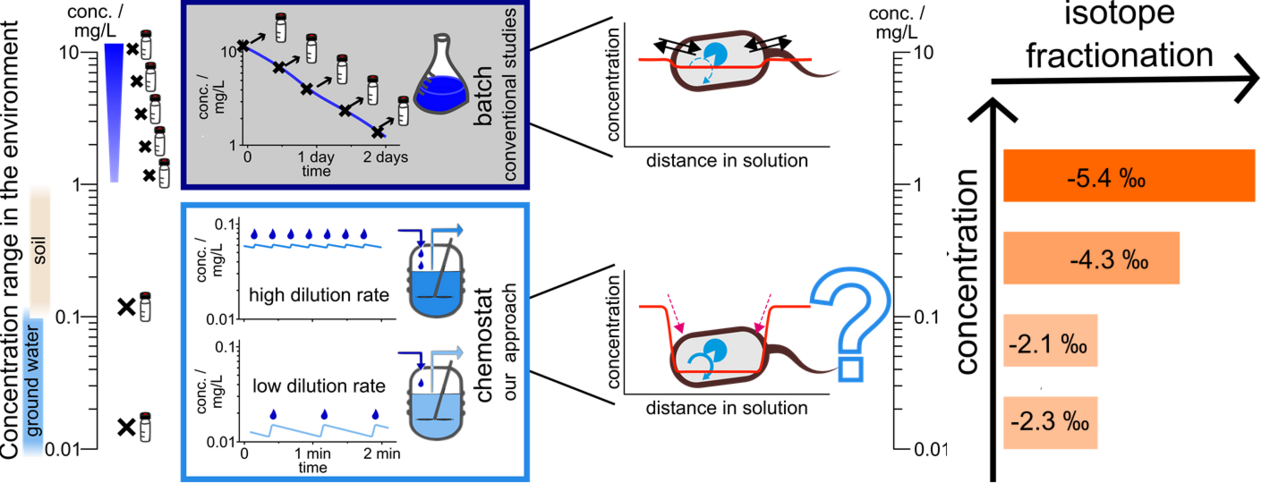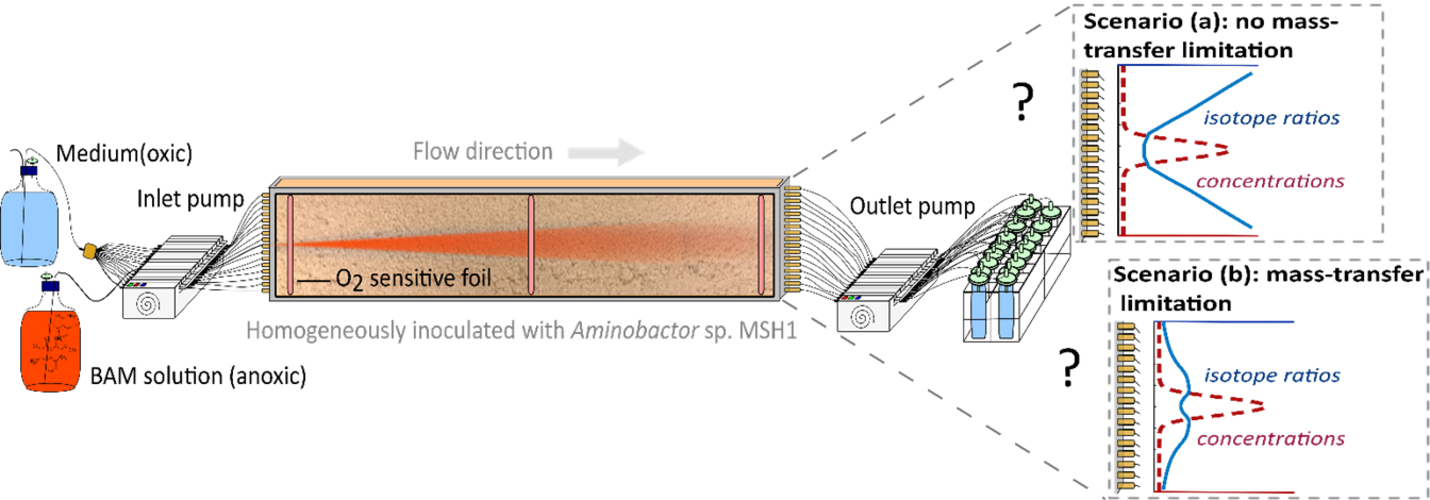ERC MicroDegrade: Bottlenecks of Micropollutant Degradation
Achievements
With compound-specific isotope fractionation analysis (CSIA) of chemical trace contaminants (“micropollutants”) the ERC project MicroDegrade could break ground in revealing bottlenecks of degradation at low, relevant (mg/L) concentrations. When enzyme-associated isotope effects were observable, this provided evidence that molecules could diffuse freely into and out of bacterial cells demonstrating that mass transfer was not limiting. In contrast, if isotope fractionation was pronounced at high concentrations, but isotope effects were masked at trace levels, this provided evidence that mass transfer into and out of the cell became limiting for biodegradation specifically at low concentrations (Ehrl et al., Environ. Sci. Technol. 2019, Marozava et al. Environ. Sci. Technol. 2019).
Sun et al. 2021 b
Implications
With the ability to directly observe mass transfer limitation, and to characterize associated physiological adaptation MicroDegrade has introduced a novel analytical approach to the investigation of microbial activity at low concentrations. It also brings forward a mechanistic explanation for the “persistence by dilution” hypothesis: that low-level water constituents such as NOM may not persistent because of inherent recalcitrance, but because of low concentrations. For Isotope Biogeochemistry the project’s findings have pronounced implications for the interpretation of isotope profiles at low concentrations: they imply that, based on isotopic evidence, turnover of substances at low concentrations may have been underestimated so far.
For bioremediation approaches of low-level concentrations, the direct observation of limitations offers an enabling tool to identify the relevant bottlenecks. Pillaring on this, we found that fluctuations in concentrations are generally faster than build-up and decay of degrader biomass, yet can profoundly influence bacterial adaptation and diversification (Kundu et al., Environ. Microbiol. 2020). Hence, variations in substrate concentrations and flow conditions may be a promising remediation approach.
Publications:
- F. Sun, A. Mellage, Z. Wang, R. Bakkour, Ch. Griebler, M. Thullner, O. Cirpka, M. Elsner, Towards improved bioremediation strategies: Response of BAM-degradation activity to concentration and flow changes in an inoculated bench-scale sediment tank. Environ. Sci. Technol. 56 (2022), DOI: 10.1021/acs.est.1c05259
- K. Kundu, A. Melsbach, B. Heckel, S. Schneidemann, D. Kanaparthi, S. Marozava, J. Merl-Pham, M. Elsner, Linking Increased Isotope Fractionation at Low Concentrations to Enzyme Activity Regulation: 4-Cl Phenol Degradation by Arthrobacter chlorophenolicus A6. Environ. Sci. Technol. 56 (2022), DOI: 10.1021/acs.est.1c04939
- K. Fenner, M. Elsner, T. Lueders, M. McLachlan, L. Wackett, M. Zimmermann, J. Drewes, Methodological advances to study contaminant biotransformation: new prospects for understanding and reducing environmental persistence?, ACS ES+T Water (2021), https://doi.org/10.1021/acsestwater.1c00025
- F. Sun, A. Mellage, M. Gharasoo, A. Melsbach, X. Cao, R. Zimmermann, C. Griebler, M. Thullner, O. Cirpka, M. Elsner, Mass Transfer-Limited Biodegradation at Low Concentrations – Evidence from Reactive Transport Modeling of Isotope Profiles in a Bench-Scale Aquifer, Environ. Sci. Technol. 55 (2021), pp. 7386–7397;
DOI: https://doi.org/10.1021/acs.est.0c08566 (b) - F. Sun, J. Peters, M. Thullner, O. A. Cirpka, M. Elsner, Magnitude of Diffusion- and Transverse Dispersion-Induced Isotope Fractionation of Organic Compounds in Aqueous Systems, Environ. Sci. Technol. 55 (2021), pp. 4772–4782; DOI: 10.1021/acs.est.0c06741 (a)
- K. Kundu, Nina Weber, Ch. Griebler, M. Elsner, Phenotypic heterogeneity as key factor for growth and survival under oligotrophic conditions, Environmental Microbiology 22 (2020), pp. 3339-3356,DOI: 10.1111/1462-2920.15106
- S. Marozava, A. Meyer, A. Perez-de-Mora, M. Gharasoo, L. Zhuo, H. Wang, O. Cirpka, R. Meckenstock, and M. Elsner, Mass Transfer Limitation During Slow Anaerobic Biodegradation of 2-Methylnaphthalene, Environ. Sci. Technol. 53 (2019) pp. 9481-9490, DOI:10.1021/acs.est.9b01152
- K. Kundu, S. Marozava, B. Ehrl, J. Merl-Pham, Ch. Griebler, M. Elsner, Defining lower limits of biodegradation – atrazine degradation regulated by mass transfer and maintenance demand in Arthrobacter aurescens TC1, The ISME Journal 13 (2019) pp. 2236–2251 DOI: 10.1038/s41396-019-0430-z
- B. Ehrl, K. Kundu, M. Gharasoo, S. Marozava, M. Elsner, Rate-Limiting Mass Transfer in Micropollutant Degradation Revealed by Isotope Fractionation in Chemostat, Environ. Sci. Technol. 53 (2019) pp. 1197–1205, DOI: 10.1021/acs.est.8b05175
- M. Gholami Gharasoo, B. Ehrl, O. Cirpka, M. Elsner, Modeling of contaminant biodegradation and compound-specific isotope fractionation in chemostats at low dilution rates, Environ. Sci. Technol. 53 (2019) pp. 1186–1196, DOI: 10.1021/acs.est.8b02498
- B.N. Ehrl, E.O. Mogusu, K. Kim, H. Hofstetter, J.A. Pedersen, M. Elsner, High Permeation Rates in Liposome Systems Explaining Glyphosate Biodegradation Associated with Strong Isotope Fractionation, Environ. Sci. Technol. 52 (2018), pp. 7259-7268, DOI: 10.1021/acs.est.8b01004
- B.N. Ehrl, M. Gharasoo, M. Elsner, Isotope Fractionation Pinpoints Membrane Permeability as a Barrier to Atrazine Biodegradation in Gram-negative Polaromonas sp. Nea‑C, Environ. Sci. Technol. 52 (2018), pp. 4137-4144, DOI: 10.1021/acs.est.7b06599
- M. Elsner, G. Imfeld, Compound-specific Isotope Analysis (CSIA) of Micropollutants in the Environment - Current Developments and Future Challenges; Current Opinion in Biotechnology, 41 (2016) pp 60–72, http://dx.doi.org/10.1016/j.copbio.2016.04.014 (invited contribution to the special issue: “Analytical Biotechnology, Stable Isotope Probing”)

